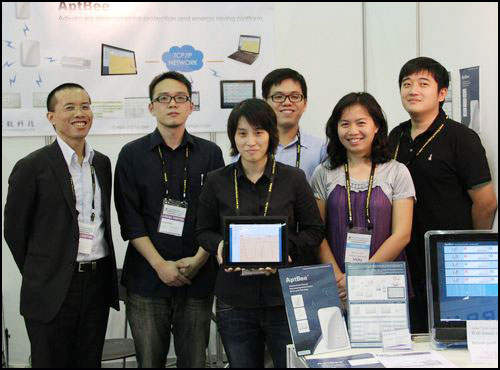Five years after radio frequency identification was first introduced into the Taipei International Electronics (TAITRONICS) exhibition, the technology is now on display in a widening variety of applications, despite the industry’s overall setbacks, such as a reduction in government funding that has whittled the number of RFID participants. Approximately 25 RFID companies exhibited their technologies this week at the event (last year, TAITRONICS reports, the number of RFID firms exhibiting at the show was 34—and in 2008, it was 50 [see Taiwan RFID Technology, Applications Showcased at International Exhibit]), featuring RFID hardware and software solutions commercially now available, as well as some technology still under development. The exhibiting companies—most of which were Taiwanese—reported a favorable amount of interest from end users passing through the electronics conference’s RFID section. Some exhibitors, however, claim that those interested in purchasing RFID-based solutions were smaller in number than at previous events.
In recent years, the annual TAITRONICS show has focused on electronic components, test and measurement equipment, LED lighting, computer processing technology and RFID. Overall attendance at this year’s exhibition was up slightly from the previous year, says Patty Lin, TAITRONICS’ publicity manager, though the number of RFID exhibitors was down. There are no statistics indicating how many visitors attended to learn about RFID, she says, noting that in general, “We received positive feedback from the visitors, and the attendees have grown 4 percent comparing with previous year.” The majority of international attendees, she adds, came from Japan, China, the United States, Korea and Hong Kong.

Some diminishing presence in radio frequency identification, Lin says, may be the result of reduced governmental funding for RFID programs. While the Taiwanese government was funding the technology’s development for city projects five years ago, according to a spokesperson at the Industrial Technology Research Institute of Taiwan (ITRI), a nonprofit research institute that exhibited at the TAITRONICS event, there is currently less funding available from the government, since the nation’s Ministry of Economic Affairs cut the funding program that it had established for RFID five years ago. What’s more, she adds, companies are now more dependent on commercial customers for their technology—software, labels, printers and readers.
At this year’s show, businesses exhibited a variety of RFID products that, in some cases, were already commercially available, and, in others, were still in the development phase.
Automatic-identification company Champtek displayed its multimedia Scan Kiosk SK50, a price checker and customer information terminal designed for use in retail locations. The device includes a bar-code scanner to check the pricing of merchandise, as well as a Near Field Communication (NFC) reader to interrogate membership or gift cards (or, in the future, an NFC-enabled cell phone), in order to determine a customer’s balance.
Syris Technology Corp. demonstrated its Xtive SYTAZG245-NW wristband, which can be used to ensure a match between a parent and an infant at a hospital, with a built-in temperature sensor to track the baby’s temperature. The wristband’s 2.45 GHz active tag employs a proprietary air-interface protocol.
AptObject, located in Taipei, has developed the prototype of a home or commercial environmental and energy-management sensor system, known as AptBee, that transmits temperature, humidity and energy-consumption data via an active ZigBee connection to a receiver, known as a “coordinator.” The receiver can be plugged into a computer’s USB port. AptBee features a sensor that can plug into a home or business power outlet, to measure the amount of energy being consumed by an electronic device plugged into that sensor, which also measures temperature and humidity, and then forwards that information to the receiver. The system can be utilized to monitor power usage, as well as deactivate an outlet remotely via a PC or smart phone with an Internet connection to the software. The software issues instructions to the coordinator, which transmits that signal back to the sensor, thereby shutting off power. The technology is not yet commercially available, though the company hopes to have it finished early next year
Summit RFID‘s C50 long-distance RFID multi-functional handheld reader works with active 2.45 GHz RFID tags to manage assets and the movements of personnel. For example, the C50 and accompanying software can identify when badge-carrying individuals enter an area, whether authorized or not, and can store information regarding which individuals are at a particular location, as well as issue an alert in the event that an unauthorized person enters a specific area. In addition, the company released a 13.56 MHz RFID reader earlier this month known as an MSG-90 auto-messaging device. According to Jessica Wu, Summit RFID’s foreign sales representative, the system includes the company’s passive RFID tags, which comply with the ISO 15693 and 14443 standards and can be embedded in students’ identity cards. Upon entering a school bus, a child can tap his or her ID card near an MSG-90 reader mounted on that vehicle, which will then capture the card’s ID number and forward that data to Summit RFID software residing on the school’s back-end system, via a cellular connection. The software can then send a text message to the child’s parent, Wu says, thereby indicating that he or she has entered the bus.
Cab Technology Co. presented its high-frequency (HF) label printer-encoders, which the company has been selling for the past five years in Asian markets, as well as in New Zealand and Australia.
ITRI has a host of RFID pilots underway in Taiwan for which it is providing consulting services. A growing percentage of those studies relate to agriculture, particularly for tracking the movements of produce, fish and flowers through the supply chain, though there is less funding for other types of projects, such as the tagging of electronics to track their movements from manufacturer to retailer. To date, according to ITRI’s staff, the cost of RFID tags is still too high for many participants in supply chain tagging programs. Some of the institute’s current pilots include tracking the habits of baby fish destined for aquariums, as well as monitoring the movements of seeds and orchids being prepared for shipment overseas (to mainland China, for instance).
TAITRONICS introduced a Taiwan RFID Pavilion to its annual show five years ago because the technology seemed to be a good inclusion among the nation’s electronic products, says Jeremy M.C. Horng, the executive director of the exhibition department at the Taiwan External Trade Development Council (TAITRA), which organizes the TAITRONICS shows. “For the past few years, we’ve tried to display different kinds of applications [for RFID],” he states, “but it has not been very successful. There have not been very many customers.” To potential customers, he adds, investing in RFID is still seen as too expensive, and a return on investment as taking too long to achieve. Although additional RFID companies will be invited to exhibit at the program in the future, Horng says, he does not expect his organization to allot a great deal of resources toward promoting Taiwan’s RFID technology and vendors.


